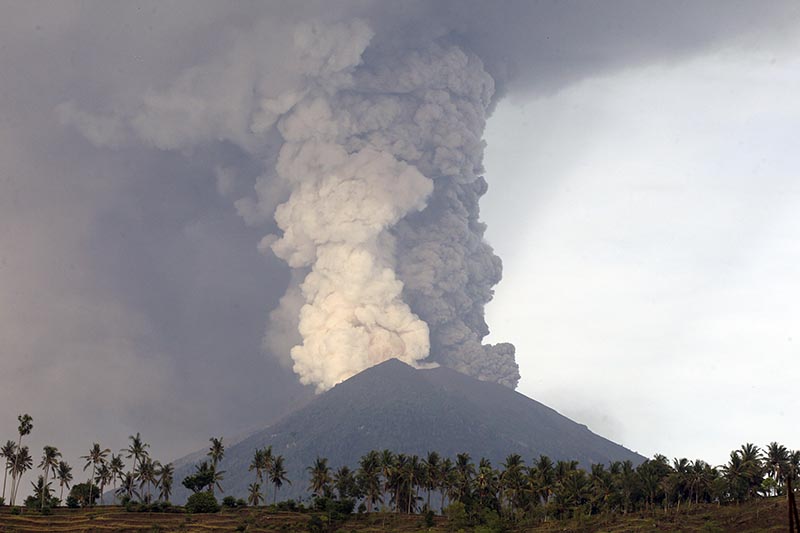Indonesia warns cold lava flows to increase from Bali's Mt Agung
JAKARTA: Cold lava flows, also known as lahar, are expected to increase amid an eruption of Mount Agung on Indonesia's tourist resort island of Bali, a disaster agency said on Monday, after sounding its highest-level warning over the volanco's activity.
"Watch out for lahar floods (cold lava) around Mt Agung," agency spokesman Sutopo Purwo Nugroho said on social network Twitter.
"Lahar floods have already occurred in several places on the slopes," he added, referring to expectations of increased rain in the current wet season. He urged people to avoid nearby river areas.
Tens of thousands stranded as Bali volcano closes airport
Associate Press
KARANGASEM, INDONESIA: Indonesian authorities raised the alert for a rumbling volcano on Bali to the highest level on Monday, stranding tens of thousands of travelers as ash clouds forced the closure of the tourist island's international airport.
Mount Agung has been hurling clouds of white and dark gray ash about 3,000 meters (9,800 feet) into the atmosphere since the weekend. Video released by the national disaster agency showed a mudflow of volcanic debris and water known as a lahar moving down the volcano's slopes.
Bali's airport was closed early Monday after tests indicated ash had reached its airspace and authorities raised the volcano's alert to the highest danger level.
Flight information boards showed rows of cancelations as tourists arrived at the busy airport expecting to catch flights home.
Airport spokesman Air Ahsanurrohim said 445 flights were canceled, stranding about 59,000 travellers. The closure is in effect until Tuesday morning though officials said the situation will be reviewed every six hours.
Bali is Indonesia's top tourist destination, with its gentle Hindu culture, surf beaches and lush green interior attracting about 5 million visitors a year.
Geological agency head, Kasbani, who goes by one name, said the alert level was raised because the volcano has shifted from steam-based eruptions to magmatic eruptions. However he said he's still not expecting a major eruption.
"We don't expect a big eruption but we have to stay alert and anticipate," he said on Indonesian TV.
The volcano's last major eruption in 1963 killed about 1,100 people.
The exclusion zone around the crater was widened to 10 kilometers (6 miles). Previously it ranged between 6 and 7.5 kilometers.
Ash up to half a centimeter (less than half an inch) thick has settled on villages around the volcano and soldiers and police distributed masks on the weekend.
In Karangasem district that surrounds the volcano, tourists stopped to watch the towering plumes of ash as children made their made to school.
Indonesia sits on the "Pacific Ring of Fire" and has more than 120 active volcanoes.
Mount Agung's alert status was raised to the highest level in September following a dramatic increase in tremors from the volcano, which doubled the exclusion zone around the crater and prompted more than 140,000 people to leave the area. The alert was lowered on Oct. 29 after a decrease in activity but about 25,000 people remained in evacuation centers.






